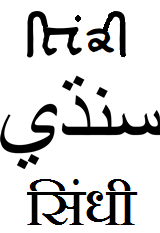Difference between revisions of "Language/Sindhi/Grammar/Plurals"
(کارو) Tags: Visual edit Reverted |
m (Reverted edits by 223.123.114.138 (talk) to last revision by Maintenance script) Tag: Rollback |
||
| Line 84: | Line 84: | ||
|} | |} | ||
== | === -ي == | ||
The suffix -ي ("-ee") is used to form the plural of some Arabic and Sindhi words. | The suffix -ي ("-ee") is used to form the plural of some Arabic and Sindhi words. | ||
Latest revision as of 00:30, 6 October 2023
Hi Sindhi learners! 😊
In this lesson, we will explore the plural forms in Sindhi grammar. Sindhi is a fascinating language that has a rich history and culture. Sindhi is spoken in the Sindh province of Pakistan and in some parts of India. Sindhi grammar has evolved over time, and it has a unique structure that makes it interesting to learn.
Once you've mastered this lesson, take a look at these related pages: How to Use "Be", Future Tense, Adjectives & Give your Opinion.
What are plurals?[edit | edit source]
Before we dive into the plurals in Sindhi, let's briefly discuss what plurals are. In English, plurals are used to refer to more than one thing. For example, the plural of "cat" is "cats," and the plural of "book" is "books." Similarly, in Sindhi, plurals are used to refer to more than one thing.
In Sindhi, plurals are formed by adding suffixes to the singular form of a noun. There are different suffixes for different types of nouns, and we will discuss them in detail in the following sections.
Plural Suffixes[edit | edit source]
There are different suffixes that are used to form plurals in Sindhi. Here are some of the most commonly used plural suffixes:
-ون[edit | edit source]
The suffix -ون ("-oon") is used to form plurals of most Arabic loanwords and some Sindhi nouns that end in a long vowel, a diphthong, or the consonant و ("waw"). Here are some examples:
| Sindhi | Pronunciation | English |
|---|---|---|
| كتاب | kitab | book |
| كتابون | kitaboon | books |
| شاتري | shaatri | friend |
| شاتريون | shaatrioon | friends |
-ين[edit | edit source]
The suffix -ين ("-een") is used to form the plural of most Sindhi nouns that have a short vowel (a, i or u) in the last syllable, and some Arabic loanwords. Here are some examples:
| Sindhi | Pronunciation | English |
|---|---|---|
| ڪلام | kalaam | word |
| ڪلامين | kalaameen | words |
| مراد | muraad | wish |
| مرادين | muraadeen | wishes |
-وه =[edit | edit source]
The suffix -وه ("-uh") is used to form plurals of some Sindhi words.
| Sindhi | Pronunciation | English |
|---|---|---|
| مون | moon | man |
| مونوه | moonooh | men |
| رانوُ | raanoo | leg |
| رانوُه | raanooh | legs |
-يه[edit | edit source]
The suffix -يه ("-yah") is used to form the plural of some Sindhi and Arabic words.
| Sindhi | Pronunciation | English |
|---|---|---|
| سرتاز | sartaaz | officer |
| سرتازيه | sartaazi-yah | officers |
| بيجليء | bijli' | electricity |
| بيجليءيه | bijli'ya | electricities |
= -ي[edit | edit source]
The suffix -ي ("-ee") is used to form the plural of some Arabic and Sindhi words.
| Sindhi | Pronunciation | English |
|---|---|---|
| سيارو | saeyaru | car |
| سياري | saeyari | cars |
| مزاهر | mazaahir | flower |
| مزاهري | mazaahiree | flowers |
It's important to note that some nouns do not follow any specific pattern for forming plurals, so it's essential to learn the plurals of each noun individually.
Dialogue[edit | edit source]
Below is a dialogue between two friends discussing plural forms in Sindhi.
- Person 1: ڪريڪٽ جو جوڙونھوند ڪتري۽ آهن؟ (Kriket jo jorroohund kitaryah aaheen?) (What are the plural forms of cricket?)
- Person 2: تهاڻ سوال کاراڻي ٿيو، ڏساڻ پريو آهيون! (Tuhinja sawaal karaanee theeeyo, dusan pareeyo aaheeyun!) (You asked a difficult question, now I have to think!)
Conclusion[edit | edit source]
In this lesson, we learned about the plural forms in Sindhi grammar. We saw that Sindhi has different suffixes for different types of nouns, and we looked at some of the most commonly used suffixes. We also saw that some nouns do not follow any specific pattern for forming plurals. To improve your Sindhi Grammar, you can also use the Polyglot Club website. Find native speakers and ask them any questions!
Sources[edit | edit source]
Upon wrapping up this lesson, take a look at these related pages: Questions, Pronouns, Negation & How to Use Have.
Videos[edit | edit source]
Singular and Plural Nouns | English in Sindhi - YouTube[edit | edit source]
Singular and Plural Nouns-Rule No:03 | English in Sindhi - YouTube[edit | edit source]
Singular and Plural Nouns-Rule No:05 | English in Sindhi - YouTube[edit | edit source]
Singular and Plural Nouns-Rule No:04 | English in Sindhi - YouTube[edit | edit source]
Singular and Plural Nouns-Rule No:02 | English in Sindhi - YouTube[edit | edit source]
Other Lessons[edit | edit source]
- Conditional Mood
- Future Tense
- Pronouns
- Negation
- Questions
- Give your Opinion
- How to Use Be
- How to Use Have
- Adjectives
